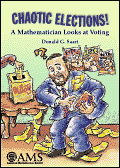 Math 217 - Voting Theory - Fall 2003
Math 217 - Voting Theory - Fall 2003
The mathematical study of voting theory began in the late 18th century, but it did not gain prominence until Kenneth Arrow's celebrated Impossibility Theorem in 1951. Most disconcerting to students new to the area are the results that there is no completely "fair" voting system and that every voting system can be manipulated through strategic voting.
Although these results are bothersome, we will see that they should not come as a surprise. One of the goals of voting theory is to understand why different procedures behave as they do so that we can identify when we have inadvertently made a bad decision. In addition to the expected applications to political elections, we will frame our discussions in terms of any group decision process. There are also some very interesting applications of voting theory to computational biology and computer science, and we will see how the problem of apportioning legislative districts easily generalizes to the much broader field of fair division.
This is going to be a really fun semester.
- Course Policies (.pdf file)
- Tentative Course Syllabus
- Reading Assignments
- A page of triangles that will be useful when considering three candidate elections (.pdf file) and a page of tetrahedra that will be useful when considering four candidate elections (.pdf file)
- Inclass exercises and other information displayed during class
- The Maple worksheet, procedure_line.mws, to draw the procedure line and approval voting region for a three candidate election
- Abstracts from the groups for their in-class presentations
- Some proportional representation (PR) references
- The Proportional Representation Library maintained by Douglas Amy at Mount Holyoke College
- The Election Commission in Cambridge, Massachusetts, which uses a form of PR in its municipal elections